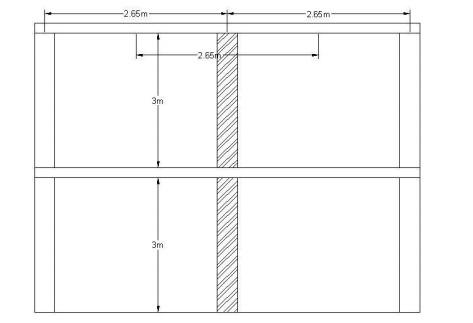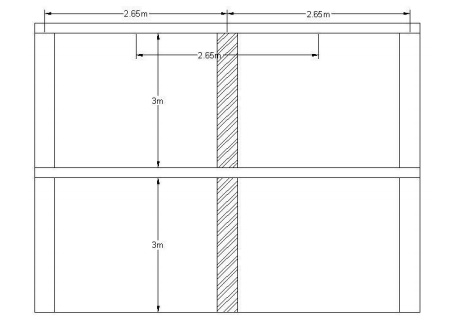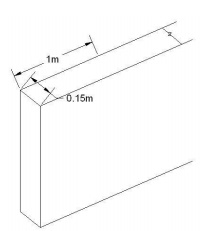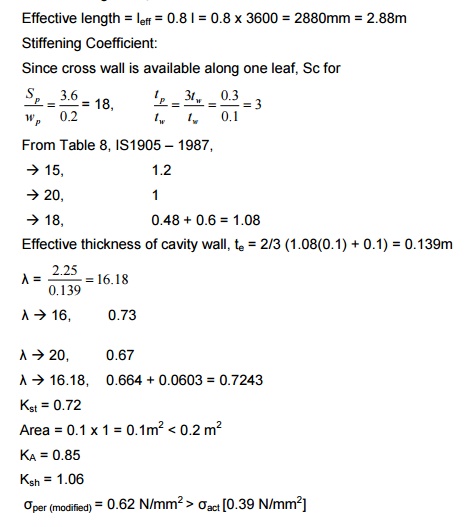Chapter: Civil : Design Of Reinforced Concrete And Brick Masonry Structures- Design Of Brick Masonry
Design Of Brick Masonry: Solved Design Problems

1. Design an interior cross
wall for a two storeyed building to carry 100mm thick RC slab with 3m storey
height. The wall is unstiffened and supports 2.65m wide slab. Loading on the
slab is given as below:
i) Live
load on floor slab = 2 kN/m2
ii) Live
load on roof slab = 1.5 kN/m2
iii) Floor
finish = 0.2 kN/m2
iv) Roof
finish = 1.96 kN/m2

Assume the compressive strength of brick as 10N/mm2
and mortar type as M1.
The loading on the wall
includes the load from slab (LL + DL) and self weight of the wall. Assuming the
wall thickness as 100mm and size of each masonry unit as 200 x 100 x 90mm,
Loading on slab: Live load:
on floor slab = 2 kN/m2 on roof slab = 1.5
kN/m2
Dead load:
Floor finish = 0.2 kN/m2 Roof finish = 1.96
kN/m2
Self weight of slabs = 2 x 0.1 x 25 = 5 kN/m2
Load from slab = 10.66 kN/m2
For 2.65m length of slab,
Load from slab = 10.66 x 2.658 = 28.36 kN/m
Self weight of masonry = 2 x 0.1 x 20 x 3 = 12 kN/m
Total = 40.36 kN/m
Permissible stress of masonry for M1 mortar and masonry
unit of compressive strength
10N/mm2 is taken from Table 8, IS 1905 -1987.
Permissible stress = 0.96 N/mm2
Stress reduction factor, Area reduction factor, Shape
modification factor are applied as per Cl.5.4.
Stress reduction factor (Kst)
Slenderness ratio (Least of le/t & he/t)
From Table 4,
he
= 0.75 H = 0.75 x 3 = 2.25m [Both ends
fixed]
he/t
= 2.25 / 0.1 = 22.5 < 27
Therefore,
the stress reduction factor from T condition is,
For
22 -> 0.56 (e = 0)
For
24 -> 0.51
For
22.5 -> 0.55
Kst = 0.55
Area reduction factor (KA)
[Cl.5.4.1.2,
IS1905-1987]
A =
0.1 x 1 = 0.1m2 < 0.2 m2
KA =
0.7 + (1.5 x 0.1) = 0.85

Shape modification factor (Ksh) [Cl. 5.4.1.3, IS1905-1987]
Ksh
for block of size 200 x 100 x 90 mm laid along 100mm side, from Table 10 for
Height to Width ratio of 90 x 100,
Height/ Width = 90/100 = 0.9
For 0.75xo à 1
For 1xo à 1.1
For 0.9xo à
1.06
Ksh =
1.06
?per
modified = Kst.KA.Ksh.
?per
=
0.55 x 0.85 x 1.06 x 0.96 = 0.48 N/mm2
?act
/m = 40.36x103 / 100x1000 = 0.4036 N/mm2 <
? per [0.48 N/mm2]
Hence the adopted thickness of 100mm with M1 mortar and
masonry unit with compressive strength 10N/mm2 is safe in carrying
the load from slab.
1. 2.In
the above problem, design the wall if it is continuous and stiffened by cross
wall of 100mm thickness and length of the wall being 3.6m.

Loading
on the masonry wall = 40.36 kN/m
Actual stress = 40.36x1000 / 100x1000 =
0.4036 N/mm2
?per for M1 mortar and masonry unit of
compressive strength 10 N/mm2 with 100mm thickness,
Permissible stress = 0.96 N/mm2 [From Table 8, IS1905 -1987]
SlendernessàLeastratio,ofHe/t&Le/t
?
He = 0.75 H = 0.75 x 3 = 2.25m
Le = 0.8L = 0.8 x 3.7 = 2.96m [From Table 5, IS1905 -1987]
For the cross walls provided, stiffening coefficients are
found from Table 6, IS1905 -1987. tp à Thickness of pier

Se = 1
Thickness of wall = 1 x 0.1 = 0.1m [Considering
stiffness]
?
=
2.25 / 0.1
= 22.5 <
27

The stress reduction factor (Kst) for Table
no.10 for ? = 22. condition,
For ? =
220.56
For ? = 240.51 For ? = 220.55.5
Kst = 0.55
Area reduction factor for area = 0.1 x 1 = 0.1m2 <
0.2m2,
KA = 0.7 + (1.5 x 0.1) = 0.85
Shape modification factor: [Cl.5.4.1.3]
Ksh for block size of 200 x 100 x 90mm laid along 100mm
side from Table 10 for height to width ratio of 90 x 100mm
Height/ Width = 90/100 = 0.9
For Ht/W = 0.75 1
For Ht/W = 1
1.1
For Ht/W = 0.9 1.06
Ksh = 1.06
?per modified
= Kst.KA.Ksh. ?per
=
0.55 x 0.85 x 1.06 x 0.96 = 0.48 N/mm2 > act?
Provided masonry wall of thickness 100mm with M1
mortar and compressive strength of each unit 10 N/mm2 is
safe.
3. Design an interior cross
wall for a two storeyed building to carry 100mm thick RC slab. Check the safety
of the wall if the wall is continuous and cross wall is available on only one
side and the storey height is 3.5m. The wall supports 2.65m wide slabs on both
sides. Loading on the slab is given as below:
i) Live
load on floor slab = 2 kN/m2
ii) Live
load on roof slab = 1.5 kN/m2
iii) Floor
finish = 0.2 kN/m2
Roof finish = 1.96 kN/m2

Assume the compressive strength of brick as 10N/mm2
and mortar type as M1. Loading on slab:
Live load:
on floor slab = 2 kN/m2 on roof slab = 1.5 kN/m2
Dead load:
Floor finish = 0.2 kN/m2 Roof finish = 1.96
kN/m2
Self weight of slabs = 2 x 0.1 x 25 = 5 kN/m2
Load from slab = 10.66 kN/m2
For 2.65m length of slab, Load from slab
Self weight of masonry Total
?act /m = 42.36x103 /100x1000 =
0.4236 N/mm2
Permissible stress of masonry for M1 mortar and masonry
unit of compressive strength 10N/mm2 is taken from Table 8, IS 1905
-1987.
Permissible stress = 0.96 N/mm2
Stress reduction factor, Area reduction factor, Shape
modification factor are applied as per Cl.5.4.
Stress reduction factor (Kst)
Slenderness ratio (Least of le/t & he/t)
From Table 4,
Effective height, he
= 0.75 H = 0.75 x 3.5 = 2.625m [Both
ends fixed]
Effective length, le
= 1.5 L = 1.5 x 3.65 = 5.475m [One end
fixed, other end free]
he/t
= 2.625 / 0.1 = 26.25 < 27
Therefore, the
stress reduction factor
from
condition is,
For 26 à
0.45 (e = 0)
For 27 à
0.43
For 26.25 à
0.3375 + 0.1075 = 0.445
Kst =
0.445
![]()
Area reduction factor (KA) [Cl.5.4.1.2,
IS1905-1987]

A = 0.1 x 1 = 0.1m2 < 0.2 m2
KA = = 0.7 + (1.5 x 0.1) = 0.85
Shape modification factor (Ksh) [Cl. 5.4.1.3, IS1905-1987]
Ksh for block of size 200 x 100 x 90 mm laid
along 100mm side, from Table 10 for Height to Width ratio of 90 x 100,
Height/ Width = 90/100 = 0.9
For 0.75xo à 1
For 1xo à 1.1
For 0.9xo à
1.06
Ksh =
1.06
![]()
?per
modified = Kst.KA.Ksh. ?per
= 0.445 x 0.85 x 1.06 x 0.96 = 0.385 N/mm2
< act?/m [0.4236 N/mm2]
Hence the adopted thickness of 100mm with M1 mortar and
masonry unit with compressive strength 10N/mm2 is not safe in
carrying the load from slab. The thickness of wall is increased to 200mm.
Load from slab = 10.66 kN/m2
For 2.65m length of slab,
Load from slab =
10.66 x 2.658 = 28.36 kN/m2
Self weight of masonry= 2 x 0.2 x 20 x 3.5 = 28 kN/m
Total = 56.36 kN/m
Loading on masonry wall = 56.36 kN/m
Actual actstress= 56.36x1000
/ 200x1000 ?=0.2818 N/mm2
Permissible stress of masonry for M1 mortar and masonry
unit of compressive strength
10N/mm2 is taken from Table 8, IS 1905 -1987.
Permissible ? per=
0.96stressN/mm2
Stress reduction factor, Area reduction factor, Shape modification
factor are applied as per
Cl.5.4.
Stress reduction factor (Kst)
Slenderness ratio (Least of le/t & he/t)
From Table 4,
Effective height, he
= 0.75 H = 0.75 x 3.5 = 2.625m [Both
ends fixed]
Effective length, le
= 1.5 L = 1.5 x 3.65 = 5.475m [One end
fixed, other end free]

he/t
= 2.625 / 0.2 = 13.125 < 27
Therefore, the
stress reduction
22.5
and no eccentricity condition is,
For
12 - > 0.84 (e = 0)
For
14 - > 0.78
For 13.125 à
0.3675 + 0.439 = 0.806
Kst =
0.806
Area reduction factor (KA) [Cl.5.4.1.2, IS1905-1987]
A = 0.2 x 1 = 0.2m2
KA = 1
![]()
Shape modification factor (Ksh) [Cl. 5.4.1.3, IS1905-1987]
Ksh for block of size 200 x 100 x 90 mm laid
along 100mm side, from Table 10 for Height to Width ratio of 90 x 100,
Height/ Width = 90/100 = 0.9
For 0.75xo à 1
For 1xo à 1.1
For 0.9xo à
1.06
Ksh =
1.06
![]()
?per
modified = Kst.KA.Ksh. ?per
= 0.806 x 1 x 1.06 x 0.96 = 0.82 N/mm2 > act?/m
[0.2818 N/mm2]
Hence the adopted thickness of 200mm with M1 mortar and
masonry unit with compressive strength 10N/mm2 is safe in carrying
the load from slab.
4. Design the interior wall
of a single storey building shown in figure. The height of the ceiling is 3.5m
and the load from slab including self weight is 30kN/m2.
Load from slab = 30 x 3.65 = 109.5 kN/m
Self weight of wall = 0.15 x 3.5 x 1 x 20 = 10.5 kN/m
Total =
120 kN/m

Actual stress = 120x1000 / 150x1000
=
0.8 N/mm2
Permissible stress of masonry for M1 mortar and masonry
unit of compressive strength 10N/mm2 is taken from Table 8, IS 1905
-1987.
2
Permissibleper= 0.96stressN/mm ?
Stress reduction factor, Area reduction factor, Shape
modification factor are applied as per Cl.5.4.
Stress reduction factor (Kst)
Slenderness ratio (Least of le/t & he/t)
From Table 4,
Effective height, he = 0.75 H =
0.75 x 3.5 = 2.625m [Both
ends fixed]
Effective length, le = 1 L = 1.0 x 8.15 =
8.15m
he/t
= 2.625 / 0.2 = 13.125 < 27
For the cross walls provided, stiffening coefficients are
found from Table 6, IS1905 -1987.

Se = 1
Thickness of wall = 1 x 0.2 = 0.2m [Considering
stiffness]
?
=
2.625 / 0.2
= 17.5 <
27
Therefore, the stress
reduction factor from Table 10 for ? = 17.5 condition is,
For 16 à
0.73 (e = 0)
For 18 à
0.67
For 13.125 à
0.1825 + 0.5025 = 0.685
Kst =
0.685
Area reduction factor (KA) [Cl.5.4.1.2,
IS1905-1987]

A = 0.15 x 1 = 0.15m2
KA =
0.7 + (1.5 x 0.15) = 0.925
Shape modification factor (Ksh) [Cl. 5.4.1.3, IS1905-1987]
Ksh for block of size 200 x 100 x
90 mm laid along 100mm side, from Table 10 for Height to Width ratio of 90 x
100,
Height/ Width = 90/100 = 0.9
For 0.75xo à 1
For 1xo à 1.1
For 0.9xo à
1.06
Ksh =
1.06
![]()
?per modified
= Kst.KA.Ksh. ?per
= 0.685 x 0.925 x 1.06 x 0.96 = 0.647 N/mm2
< act?/m [0.8 N/mm2]
Hence the adopted M1 mortar and masonry unit with
compressive strength 10N/mm2 is not sufficient in carrying
the load.
Increase the strength of brick unit and mortar as,
H1 mortar and masonry unit
compressive strength 15N/mm2
?per = 1.31 N/mm2
?per modified = 0.88 N/mm2
Therefore, the interior wall
of 150mm thickness is safe with H1 mortar and brick units of compressive
strength 15 N/mm2.
5. Design a masonry wall of
height 4m subjected to a load of 20kN/m. Use M1 mortar. The wall is
unstiffened[no need to find effective length] at the ends.
Assume a thickness of wall of 300mm
Actual stress = 20x1000 / 300x1000 =
0.066N/mm2
?per = 0.96 N/mm2
He = 0.75 H = 0.75 x 4 = 3m
?
= 3/0.3 = 10
Kst = 0.89
For A = 0.3 x 1 = 0.3 m2, KA = 1 Ksh = 1.06
?per modified = 0.27 N/mm2 > act?[0.066
N/mm2] Hence, safe.
6. Design the wall in the GF level for the loading
condition as shown in figure.

Loading on brick wall:
Load from slab = 12 + 10 + 10 Weight of wall =
32 kN/m
(self wt.) = 3 x 2 x 0.1 x 3 x 20 = 36 kN/m
Total = 68 kN/m
Actual stress = 68x1000 / 2x100x1000
= = 0.34 N/mm2
Use M1 mortar and brick of compressive strength 10 N/mm2.
?per = 0.96 N/mm2 [From Table 8, IS1905 -1987]
(? ? 6)
heff = 0.75 x h = 0.75 x 3 = 2.25m
te = 2/3(tw + tw)
= 2/3(0.1 + 0.1) = 0.133m

![]() ?à 16.875,
(0.421875 + 0.293125 = 0.715)
?à 16.875,
(0.421875 + 0.293125 = 0.715)
Area of wall (each leaf) = 0.1 x 1 = 0.1m2
< 0.2 m2 KA = 0.85
Ksh = 1.06
?per (modified)
= Kst x KA x Ksh x per?
=
0.704 x 0.85 x 1.06 x 1.96 = 0.61 N/mm2 > act?
Therefore, the cavity wall
is safe with M1 mortar and masonry unit of compressive strength 10N/mm2.
2.Design a cavity wall of overall thickness
250mm and thickness of each leaf 100mm for a three storeyed building. The wall
is stiffened by intersecting walls 200mm thick at 3600mm c/c. The ceiling
height is 3m and the loading from roof is 16 kN/m. The loading from each floor
is 12.5kN/m.

Load from roof = 16kN/m
Load from floor = 12.5 + 12.5 kN/m
Wall load [3x0.2x20] = 36 kN/m
Total
= 77 kN/m
Actual
stress = ?ac= 77x103
/ 200x1000 = ==0
.39N/mm2
?per :
Assume M1 mortar and brick of compressive strength 10
N/mm2. From Table 7, IS1905 -1987,
?per = 0.96 N/mm2 (? ? 6) Effective
height = heff = 0.75 x 3 = 2.25m
Effective length = leff = 0.8 l = 0.8 x 3600 =
2880mm = 2.88m Stiffening Coefficient:
Since cross wall is available along one leaf,
Sc for

3. Design a masonry column to carry a load of 150kN. The
height of the column is 2000mm. The column is restrained against translation
(hinged) only.
Assume a column of size 400 x 400mm.
Use M1 mortar and brick of compressive strength 10 N/mm2.

heff = h [Table 4, IS1905-1987]
?
=
2000/400 = 5
< 6
There is no need for Stress reduction factor (Kst
= 1)
2
From Tableper=0.967,N/mm?
Ast = 0.4 x 0.4 = 0.16m2 < 0.2m2
KA = 0.7 + (1.5 x 0.4 x 0.4) = 0.94 Ksh = 1.06
?per (modified) = 0.94 x 0.96 x 1 x 1.06 =
0.98 N/mm2.
?act < per?
Therefore, the masonry
column of size 400 x 400mm with M1 mortar and brick unit of compressive strength
10N/mm2 is safe to carry a load of 150kN.
Note: Boundary condition is assumed if not given.
4.Design an interior wall of a single
storeyed workshop building of height 5.4m supporting a RC roof. Assume roof
load as 45kN/m. The wall is stiffened by piers at equal intervals shown in
figure. Height = 5.4m, w = 45 kN/m
Since there is an increase
in width at the pier, the actual stress is found for the wall length of 3.6m
(One bay).

C/s area of one bay = (3.6 x 0.2) + 4(0.1 x
0.1) = 0.76 m2
?per:
heff = 0.75h = 4.05m [Table 4, IS1905-1987]
demise leff = 0.8l = 0.8 x 3.6 = 2.88m
?
=
2.88 < 6
There is no need for Stress reduction factor (Kst
= 1)
2
From Tableper=0.967,N/mm?
Ast = 0.4 x 0.4 = 0.16m2 < 0.2m2
KA = 0.7 + (1.5 x 0.4 x 0.4) = 0.94 Ksh = 1.06
?per (modified) = 0.94 x 0.96 x 1 x 1.06 =
0.98 N/mm2.
?act < per?
Therefore, the masonry
column of size 400 x 400mm with M1 mortar and brick unit of compressive
strength 10N/mm2 is safe to carry a load of 150kN.
Stiffening coefficient,

?per (modified) = 0.785 x 0.96 x 1 x 1.06 =
0.79 N/mm2 > act?
Inference : Hence the brick
wall is safe with M1 mortar and brick of compressive strength 10N/mm2.
5.Design a brick masonry column of height 3m,
tied effectively, fixed at top and bottom. The load from slab is 100kN,
including self weight of the brick pillar.
Load from slab = 100Kn
Self weight of brick pillar = 0.4 x 0.4 x 20
x 3 = 9.6kN
Total =
109.6 kN
Assume a column size of 400mm x 400mm.
Actual stress = 109.6x103 / 400x400 =
0.685 N/mm2
Assume grade of mortar as M1 and compressive
strength of 0.96N/mm2 heff = 0.75.H = 2.25m

There is no need of stress reduction factor. Kst
= 1
A = 0.4 x 0.4 = 0.16 m2 < 0.2m2
KA = 0.7 + (1.5 x 0.4 x 0.4) = 0.94
Ksh = 1.06
[Brick unit 200 x 100 x 90]
?per (modified) = 0.9565 N/mm2 >
act?
Hence the brick wall is safe with M1 mortar
and compressive strength of 10N/mm2.
6.Design an interior wall of a 3 storeyed
building with ceiling height of each storey as 3m. The wall is unstiffened and
3.6m in length. Load from roof is 12kN/m and from each floor is 10kN/m. Select
a cavity wall with overall thickness 250mm and length between each leaf as
50mm.

h = 3m, l = 3.6m
Load from roof = 12
kN/m
Load from each floor = 10
+ 10 kN/m
Self weight of wall
= 3 x 2 x 0.1 x 3 x 20 = 36 kN/m
Total = 68 kN/m

Use M1 mortar and brick of compressive strength 10N/mm2,
?per = 0.96 N/mm2
heff = 0.75 x 3 = 2.25m te = 2/3(tw
+ tw) = 0.133m

From Table 8, IS1905 -1987, Kst = 0.704
Area of wall = 0.1 x 1 = 0.1 m2 < 0.2 m2
KA = 0.85
Ksh = 1.06
?per (modified) = 0.704 x 0.85 x 1.06
x 0.96 = 0.61 N/mm2 > act?
Hence the brickwork is safe with M1 mortar and brick of
compressive strength 10N/mm2.
Related Topics